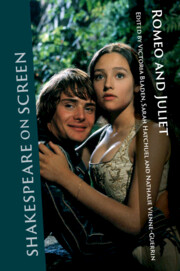Book contents
- Shakespeare on Screen: Romeo and Juliet
- Series page
- Shakespeare on Screen: Romeo and Juliet
- Copyright page
- Dedication
- Contents
- Figures
- Notes on Contributors
- Series Editors’ Preface
- Acknowledgements
- Chapter 1 Introduction – From Canon to Queer: Romeo and Juliet on Screen
- Part I Revisiting the Canon
- Part II Extending Genre
- Part III Serial and Queer Romeo and Juliets
- Chapter 11 Romeo and Juliet, Again and Again: Star-Crossed Lovers Adapted to Serial Television
- Chapter 12 Romeo and Juliet in the Japanese Anime Candy Candy: The Balcony Scene between Tradition and Subversion
- Chapter 13 The (Un)Queering of Romeo and Juliet on Film
- Chapter 14 Romeo and Juliet and Queer Temporality in Three Twenty-first-century Streaming Web-Series
- Chapter 15 Reviving Juliet and Surviving Romeo in Shakespeare Web-Series
- Chapter 16 Romeo and Juliet on Screen: Select Film-bibliography
- Index
- References
Chapter 15 - Reviving Juliet and Surviving Romeo in Shakespeare Web-Series
from Part III - Serial and Queer Romeo and Juliets
Published online by Cambridge University Press: 10 October 2023
- Shakespeare on Screen: Romeo and Juliet
- Series page
- Shakespeare on Screen: Romeo and Juliet
- Copyright page
- Dedication
- Contents
- Figures
- Notes on Contributors
- Series Editors’ Preface
- Acknowledgements
- Chapter 1 Introduction – From Canon to Queer: Romeo and Juliet on Screen
- Part I Revisiting the Canon
- Part II Extending Genre
- Part III Serial and Queer Romeo and Juliets
- Chapter 11 Romeo and Juliet, Again and Again: Star-Crossed Lovers Adapted to Serial Television
- Chapter 12 Romeo and Juliet in the Japanese Anime Candy Candy: The Balcony Scene between Tradition and Subversion
- Chapter 13 The (Un)Queering of Romeo and Juliet on Film
- Chapter 14 Romeo and Juliet and Queer Temporality in Three Twenty-first-century Streaming Web-Series
- Chapter 15 Reviving Juliet and Surviving Romeo in Shakespeare Web-Series
- Chapter 16 Romeo and Juliet on Screen: Select Film-bibliography
- Index
- References
Summary
I will explore how web-series adaptations of Romeo and Juliet challenge and revise the famous (and infamous) narrative of the star-crossed lovers. Participating in a new model for Shakespeare on screen, these series change the plot of Shakespeare’s Romeo and Juliet, expanding the number and variety of the female characters, adapting Shakespeare to address issues of gender, sexuality and love in the digital age. The young women who create web-series such as Any Other Rosie, Any Other Vlog, Jules and Monty and Rome and Juliet shift the viewer’s focus away from Juliet and her complicated legacy.
Keywords
- Type
- Chapter
- Information
- Shakespeare on Screen: Romeo and Juliet , pp. 231 - 241Publisher: Cambridge University PressPrint publication year: 2023

